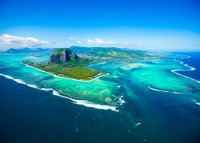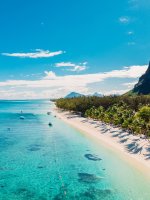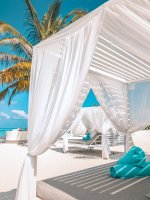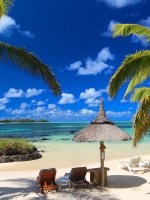When the first settlers arrived on Rodrigues, they found an island largely swathed in woodland and populated by a bizarre ensemble of animals. These included two species of giant tortoises, fruit bats, herds of dugong in the lagoons and a variety of endemic birds.
Most conspicuous of these were the Rodrigues solitaire (Pezophaps solitaria), the island’s answer to the Mauritian dodo. These extraordinary creatures shared their Mauritian cousins’ fate and were soon exterminated. Trade in the two species of giant tortoise began in 1736. By the turn of the 19th century, they too were extinct.
Of 17 endemic species of vertebrate, just three remain: the Rodrigues warbler (Acrocephalus rodericanus), Rodrigues fody (Foudia flavicans) and the Rodrigues fruit bat (Pteropus rodericensis).
The two surviving endemic bird species are both threatened. The greyish Rodrigues warbler is classed ‘endangered’. A survey in 1974 recorded just 32 warblers, by 1999 the number had climbed to 150, and in 2010 the population was at 4,000. The increase is largely the result of habitat restoration by the Mauritanian Wildlife Foundation.
The pretty yellow and orange Rodrigues fody is classed as ‘vulnerable’ but is in line to be reclassified as ‘near-threatened’ after a survey in 2010 revealed a population of around 8,000. This is a marked improvement on the numbers from 1974, when there were just 30 individuals.
To see the endemic birds, go to the Grand Montagne Nature Reserve, the areas along the island’s central ridge, the woods around Cascade Pigeon River or Solitude, not too far from Port Mathurin. You should find both species within half an hour.
The endemic Rodrigues fruit bat is the last remaining indigenous mammal. As a result of conservation efforts, the population of Rodrigues fruit bats numbered around 10,000 in 2011. Once, these famed ‘blonde bats’ were on the verge of oblivion. They were down to a population of fewer than 100 during the mid 1970s when the late Gerald Durrell and the Jersey Wildlife Preservation Trust (now the Durrell Wildlife Conservation Trust) undertook a collecting expedition to Rodrigues and Mauritius (see box The Durrell Wildlife Conservation Trust in the Mascarenes, pages 200–1). Thanks to the intensive captive-breeding efforts which followed the JWPT expedition, along with habitat creation and restoration and sensitisation campaigns throughout Rodrigues by the Mauritian Wildlife Foundation, the bat population has increased substantially. Bats can be seen any time of the day, roosting in trees but they are easiest to spot from about 16.00 when they fly from their daytime rest sites. The best places to see them include Solitude, between Port Mathurin and Mount Lubin, or near Malabar.
Owing to continuous reforestation work, the outlook for the Rodrigues fody, Rodrigues warbler and Rodrigues fruit bat is bright, provided that their forest habitat is safeguarded.
Endangered flora Most of the 49 endemic plant species are rare with fewer than five wild plants found throughout the island. These include the madrinette (Hibiscus liliiflorus), a hibiscus endemic to Rodrigues, which has been saved from extinction. This was done after only two were found to remain on Rodrigues itself. One of the world’s rarest plants, ‘café marron’ (Ramosmania rodriguesii), is Rodriguan. A lone specimen remains in the wild on the island, just off the road near Mont Plaisir, where it is carefully fenced in. In 1986, cuttings were sent to Kew Gardens, where one took root. Several have also been produced in Rodrigues since the 1990s and there are now hundreds at Kew. Many of the island’s indigenous plants are shared with the other Mascarenes, where they are usually more numerous.
The critically endangered shrub, ‘figue marron’ (Obetia ficifolia), is extinct on Mauritius but is shared with Réunion, where it is known to be pollinated by a single, endangered species of butterfly. Another rare shrub is the ‘bois cabris’ (Clerodendron laciniatum); growing to 3–4m high, it bears small clusters of white flowers. The hardwood tree ‘bois d’olive’ (Cassine orientalis), which attains a height of 20m, was once used to make furniture.
